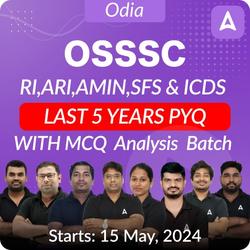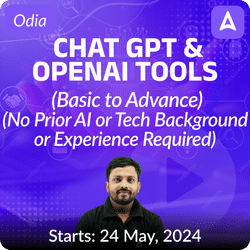Prepare for the OSSC CGL with these Top 30 Computer Awareness MCQs, designed to enhance your knowledge. Covering fundamental concepts in computing, from hardware to software and beyond, these questions aim to sharpen your understanding and boost your confidence. Whether you’re familiarizing yourself with basic terminology or delving into more advanced topics, this curated set ensures comprehensive preparation. Master concepts like operating systems, networking, and data structures, vital for success in the OSSC CGL examination. Elevate your computer awareness proficiency and ace the test with ease.
Top 30 Computer Awareness MCQs For OSSC CGL
- Which Video Card Works Best for 3D Games?
(a) ATI 3D Charger
(b) Nvidia GeForce 256 DDR
(c) ATI Radeon 9700 Pro
(d) 3DFX VooDoo 5
Answer: Option (c)
Explanation:
The ATI Radeon 9700 Pro is the best video card for 3D games. This card excels in rendering cutting-edge games, offering features like TV watching, DVD viewing, background recording while watching live TV, camcorder footage capturing and editing, and burning video CDs and DVDs, making it a standout choice in ATI’s All in Wonder product range. - Which of the following is a holding place for data, instructions, and information that is located on chips attached to the system board?
(a) program
(b) mouse
(c) Internet
(d) memory
Answer: Option (d)
Explanation:
Memory is the component in a computer where data and instructions are stored for processing. It consists of numerous small bits or cells, each with a unique address ranging from zero to memory size minus one. - Which of the aforementioned auxiliary devices shows information to the user?
(a) Monitor
(b) Keyboard
(c) Secondary storage devices
(d) Secondary storage media
Answer: Option (a)
Explanation:
The monitor is an external hardware device connected to a computer that displays information to the user. Peripheral devices like the monitor allow users to interact with the computer. - One way to put a memory management system into practice is:
(a) Bridgeware
(b) Broadband coaxial system
(c) Buddy system
(d) All of the above
Answer: Option (c)
Explanation:
The buddy system is a memory management algorithm that uses variable-sized partitions, simplifying the allocation of blocks of the correct size. - Ques 5. What kind of chips are thought to be volatile?
(a) ROM chips
(b) RAM chips
(c) DRAM
(d) All of the above
Answer: Option (b)
Explanation:
RAM (Random Access Memory) chips are volatile, meaning they require power to maintain stored information. When the computer is turned off, the data stored in RAM is lost. - The computer adheres to a straightforward rule known as GIGO, which stands for:
(a) garbage in garbage out
(b) garbage input good output
(c) great instructions great output
(d) good input good output
(e) None of the above
Answer: Option (a)
Explanation:
GIGO (Garbage In, Garbage Out) signifies that the quality of output is determined by the quality of the input. If the input is flawed, the output will also be flawed. - Which of the following was used by second-generation computers?
(a) Transistors
(b) IC-Chip
(c) Vacuum tubes
(d) Microprocessor chip
Answer: Option (a)
Explanation:
Second-generation computers, used between 1957 and 1963, utilized transistors and magnetic cores, leading to more efficient and reliable machines compared to their vacuum tube predecessors. - Which of the following is not hardware?
(a) An MP3 file
(b) A keyboard
(c) A disk drive
(d) A monitor
Answer: Option (a)
Explanation:
An MP3 file is software, not hardware. The other options are physical components (hardware) of a computer. - In a 2048 x 4 memory chip, how many address lines are required to address each memory location?
(a) 10
(b) 12
(c) 8
(d) 11
Answer: Option (d)
Explanation:
A 2048 x 4 memory chip requires 11 address lines to address each memory location, accommodating the 2048 distinct addresses needed. - What is a multiplexer?
(a) One into many
(b) many into many
(c) many into one
(d) All of the above
Answer: Option (d)
Explanation:
A multiplexer is an electronic device that selects one of many input signals and forwards it to a single output line, making it versatile in handling multiple data inputs. - Which types of computers are employed in the field of weather forecasting?
(a) Supercomputers
(b) Notebook computers
(c) Jon Von Neumann computers
(d) All of the above
Answer: Option (a)
Explanation:
Supercomputers are used in weather forecasting to handle the vast amounts of data and complex calculations required for accurate weather models. - Which was the first microprocessor?
(a) 8080
(b) Intel 4004
(c) 8085
(d) 4008
Answer: Option (b)
Explanation:
The Intel 4004 was the first microprocessor, created using 2-inch wafers, making it one of the smallest microprocessor designs to enter commercial production. - What is the most effective approach to navigating a 3D environment?
(a) Use a tracker ball
(b) Use a keyboard
(c) Use a space mouse
(d) Use Joystick
Answer: Option (c)
Explanation:
A space mouse, with its advanced 6-degrees-of-freedom sensor, is the most effective tool for navigating a 3D environment, providing precise control over 3D movements. - Computer-readable codes made out of bars or lines with different widths or lengths are referred to as —
(a) an ASCII code
(b) a magnetic tape
(c) a bar code
(d) an OCR scanner
Answer: Option (c)
Explanation:
A barcode is a machine-readable representation of numbers and characters using bars and spaces, commonly seen on product packaging for scanning and identification. - Electronic computers built with vacuum tubes are?
(a) Second generation
(b) Hoover generation
(c) First generation
(d) All of the above
Answer: Option (c)
Explanation:
First-generation computers used vacuum tubes for their logic circuitry. Despite being replaced by transistorized computers, vacuum tube computers continued to be produced into the 1960s. - What are peripheral devices monitors and computers are?
(a) Data
(b) Software
(c) Hardware
(d) Information
Answer: Option (c)
Explanation:
Peripheral devices and monitors are hardware components that connect to the main computer system, enhancing its functionality for the user. - Which computer memory is utilised to store the software and information that the CPU is now processing?
(a) Mass memory
(b) Non-volatile memory
(c) PROM
(d) Internal memory
Answer: Option (d)
Explanation:
Internal memory, or primary memory, stores data and instructions that the CPU is currently processing, ensuring quick access and smooth operation of active software. - What RAM configuration works BEST with the Intel Pentium 4 processor?
(a) SDRAM
(b) DDR SDRAM
(c) EDO/Fast Page Ram
(d) Rambus
Answer: Option (a)
Explanation:
SDRAM is the most effective RAM configuration for the Intel Pentium 4 processor, providing the required speed and compatibility for optimal performance. - What is located on the motherboard and connects the CPU to other motherboard components?
(a) Input Unit
(b) System Bus
(c) ALU
(d) Primary Memory
Answer: Option (b)
Explanation:
The system bus is located on the motherboard and connects the CPU to other components, combining data, address, and control buses for efficient communication. - The address of the memory location where the next instruction is located is tracked by which of the following registers?
(a) Memory address register
(b) Memory data register
(c) Instruction register
(d) Program counter
Answer: Option (d)
Explanation:
The program counter is a register in the CPU that holds the address of the next instruction to be executed, incrementing after each instruction is fetched. - Which of the following describes an excess of power that could result in a voltage surge?
(a) Anomaly
(b) Shock
(c) Spike
(d) Virus
Answer: Option (c)
Explanation:
Lightning, static electricity, magnetic forces, and internal variations in voltage consumption can all result in voltage spikes and surges. The use of a surge protector is the best technique to safeguard your electronic devices. - The magnetic strip is found at which location?
(a) Speakers
(b) Credit card
(c) Smart card
(d) All of the above
Answer: Option (b)
Explanation:
Magnetic stripe cards are currently used in identification cards for employees, credit cards, hotel rooms, gift cards, and public transportation. A magnetic strip can encode or decode data using an electromagnetic method for automatic reading, decoding, or recognition by a machine that detects magnetic fluctuations on the strip. - The compiler can identify the following mistakes:
(a) Logical errors
(b) Semantic errors
(c) Syntax errors
(d) All of the above
Answer: Option (c)
Explanation:
Syntax errors are the kind of errors that the compiler can flag. In computer science, a syntax error refers to a mistake in the order of characters or tokens that are meant to be written in a specific programming language. - What kind of thing is a daisy wheel?
(a) Printer
(b) Storage device
(c) Pointing device
(d) All of the above
Answer: Option (a)
Explanation:
Andrew Gabor at Diablo Data Systems created the daisy wheel printing process in 1970. It is an impact printing technology that produces high-quality output, similar to luxury typewriters like the IBM Selectric, but at two to three times the speed using replaceable pre-formed type components, each with typically 96 glyphs. - A tool for altering the configuration of a connector’s connection is:
(a) a converter
(b) a component
(c) an attachment
(d) an adapter
Answer: Option (d)
Explanation:
An adapter is a tool used to change the configuration of a connector’s connection. - Which one of the following qualifies as secondary memory?
(a) Disk
(b) Keyboard
(c) ALU
(d) All of the above
Answer: Option (a)
Explanation:
In secondary memory, data and programs are permanently preserved. The most common types of secondary storage media are hard disks and floppy disks. The storage capacity of a hard drive is enormous compared to the system’s main memory. - Travel agents use the following computer system while booking flights:
(a) Supercomputer
(b) Mainframe computer
(c) Personal computer
(d) All of the above
Answer: Option (c)
Explanation:
Travel agents use personal computers for booking flights as they are user-friendly and suitable for the required tasks. - Ques 8. The name of the language that a computer can comprehend and use is:
(a) Application software
(b) Machine language
(c) System program
(d) All of the above
Answer: Option (b)
Explanation:
The fundamental language of computers is machine code, also referred to as machine language. It is composed of digital binary integers, is read by the computer’s central processing unit (CPU), and appears as a long string of zeros and ones. - Which of the following storage units is highest in capacity?
(a) KB
(b) GB
(c) MB
(d) TB
Answer: Option (d)
Explanation:
A terabyte (TB) is larger than a gigabyte (GB). A megabyte (MB) is 1,024 kilobytes (KB), while a terabyte is 1,024 gigabytes. - Registers that are used to hold conditional information and are only partially visible to users are known as:
(a) PC
(b) General purpose register
(c) Memory address registers
(d) Flags
Answer: Option (d)
Explanation:
Flags are registers that hold conditional information and are partially visible to users. They store the status of various operations and conditions within the CPU.





